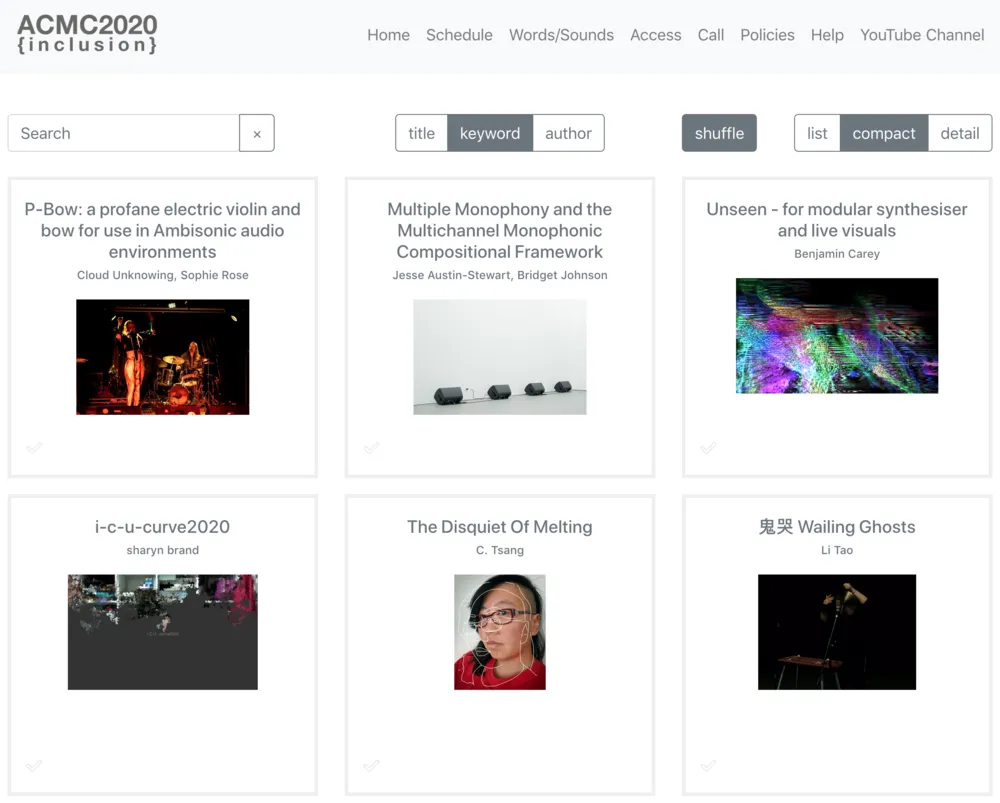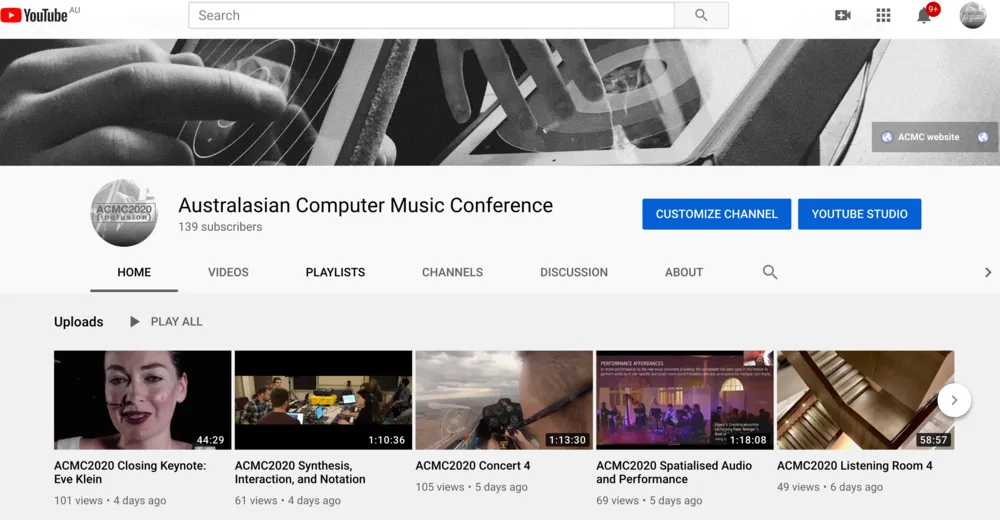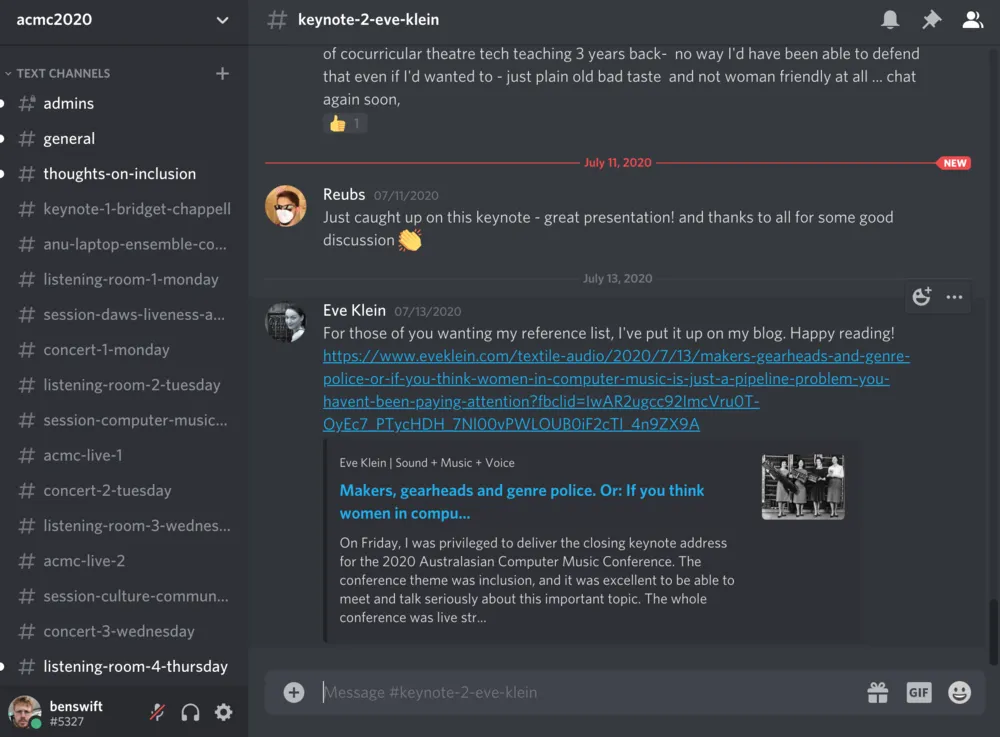I’ve been a bit quiet on this blog for the last few weeks[1] because I’ve been organising ACMC2020: the 2020 Australasian Computer Music Conference. From the conference landing page:
This year’s conference theme is inclusion. We want to highlight the diverse range of people who contribute to Australia’s computer/electronic music culture but may not normally attend an academic conference, including artists and scholars who are young/emerging, from regional/remote areas, who have a disability, who are First Nations People, who have low/no income, who are engaged in community music making, or who simply work outside of academia and mainstream institutions.
Well, the conference is now all done for 2020 (although the videos are still freely available online; check out our keynotes). It’s been a lot of hard work, but the ACMC community are amazing, so it’s been pretty fun as well. A special shout out to the rest of the ACMC organising committee (Charles, Nat, Sia, Kit & Alec) for all their hard work—thanks team 😃 So even though I’m writing this blog post, these decisions & reflections are really the result of our combined labour, as well as feedback from the ACMC community during the conference.
Tools for running an online conference in 2020
This post isn’t about the success (or otherwise) of ACMC2020 as an inclusive, affirming computer music conference. I care about that a lot, and that post is in the works, but this isn’t it.
Instead, this post is a list of all the tools that we chose to use to put it all together, and the rationale behind those decisions. There are lots of people all around the world organising virtual conferences right now, so hopefully writing down our experiences is helpful.
As the hosts of a virtual ACMC, our priorities were:
to minimise the risk technical difficulties, “live” activities were limited to those where they add value (for example all talks were pre-recorded & watched on YouTube to avoid the technical issues which come with live screen-shared zoom presentations)
use synchronous communication modes for discussion and q&a, but with persistence: leave participants the option of returning to a discussion later (or for leaving a question for a presenter in a different timezone, to be answered at a friendlier time for them)
where possible, use low-cost (because the ACMC doesn’t have a huge budget) and open-source tools (so that the things we learn can be built upon by others)
automate all the things; it probably goes without saying if you know me or read my blog, but manual work makes me sad and continuous integration pipelines make me happy ☺
tl;dr
we used EasyChair for submissions & peer review, a customised version of ICLR’s website, YouTube premiere, and Discord for text/voice discussion and q&a
Conference website
Initially we threw up simple Jekyll site (hosted using GitHub Pages) with the basic conference info & Call for Papers. This was super-easy and did the job through the initial phase of advertising the conference and drumming up submissions.
Around the time we were finalising the accepted papers & conference schedule, the ICLR team posted on HN that the tooling for their virtual conference was newly available on GitHub. We decided to use it as a starting point for building the ACMC2020 conference website.
The final version of the ACMC site is still live (and will remain so for a while at least) at https://acmc2020.com/, and the source is up on GitHub as well.

Reflections
in the end I think it looked really great (and we received some nice feedback from the creators of the template) but it was a lot of work requiring a non-trivial amount of web development experience to get it to that point (Charles Martin helped a lot with this)
a static site which is automatically populated based on data in a CSV or YAML file is a good option—it means as long as whatever system you’re using to organise & schedule the accepted papers can output a
.csvfile you can probably make it work with this website templateif I had my time again, I’m undecided as to whether I’d use the same Mini-Conf template as a starting point, or just write a new Jekyll plugin which adds similar features (and just has a more mature docs/ecosystem for static site building)
Submissions & peer review
We used EasyChair for conference submissions, partially because the small-ish size of the conference meant that we were able to sneak in under the limits for their free tier. While the reviewing & final decisions were done through EasyChair, at the end of that process we exported all the accepted submissions as a big .csv file (which we imported into Google Docs—see below).
Reflections
since the ACMA has its roots in academia, the majority of the audience for this conference are familiar with the whole “call for papers -> peer review -> notification -> conference attendance” thing, however there were certainly people for whom this process was unfamiliar and a bit daunting (so we need to provide more guidance for those folks next time)
EasyChair sucks, but the others (Precision Conference, CMT) suck too, so I wouldn’t strongly push people one way on the other on this part of the process—as long as your choice allows you to export all accepted submissions & their metadata in some sort of machine-readable format (e.g. CSV, YAML)
Scheduling/programming the sessions
EasyChair worked fine for distributing the submissions for peer review & selecting the ones we wanted in the conference. It doesn’t really have a nice story for how to organise those submissions into a coherent conference program.
To do this, we used a shared Google Docs spreadsheet. Starting with the CSV export from EasyChair, the ACMC committee added columns about which presentations should go in which sessions and in which order. To get this data into the conference website we needed to manually “Download as .csv”, then copy the file into the sitedata folder ready to be picked up by the next build of the conference website.
Reflections
ACMA is lucky that most of our community[2] is based in Australia across a relatively small range of timezones—if you’re running an international conference then you need to think about the chronodiversity of your participants when you’re scheduling your conference sessions (my colleague Steve Blackburn has a blogpost in the works about this)
this step required the most manual work (in particular the manual “Download as
.csv” step) which was certainly a hassle in the early stages of the scheduling process when things are changing a lot, however the convenience & familiarity of a spreadsheet was a net winthe website infrastructure has a place for putting python scripts, and we used this a lot to run consistency checks & other helpful analyses (because checking stuff with scripts is way more fun than checking it by eye, and probably a time-saver…)
Video presentations
All the AV content for the conference was streamed to “attendees” on YouTube. ACMC isn’t a traditional academic conference—there are audiovisual computer music performances alongside more traditional paper presentations—but we put everything on YouTube nonetheless.
A couple of the performances were livestreamed, but for the majority of the conference program participants were asked to submit a video representing their performance or paper presentation. Then, an elaborate series of ffmpeg scripts[3] concatenated the videos to produce a single video per session, with consistent “titlecards” announcing the authors & title of each new video in the session.
Each session video was uploaded to YouTube, and scheduled for “simultaneous viewing” at the scheduled time using the YouTube Premiere feature. After the Premiere, the videos were (still are) left up on the ACMC YouTube for people to catch up & watch at their leisure.

Reflections
outsourcing the video delivery to YouTube (who, regardless of what you think of their business model, are really good at delivering video) saved so much stress
the ability to upload & schedule the video ahead of time but still watch it all-together allows for synchronous discussion and q&a amongst attendees
when the premiere is done, you don’t have to “put the videos online for those who missed them”; they’re already there (which is so much easier than having to make talk recordings, edit them together, and then upload them somewhere)
YouTube’s analytics are also really good, if you’re into that sort of thing, and you even get stuff like half-decent automatic subtitling and other accessibility wins
it’s hard to know what sort of viewership counts as “successful”, but the ACMC conference videos (in total) are currently at 2.2k views and ~500h watch time
in terms of wranging the videos pre-upload,
ffmpegis amazing for dealing with all the weird audio/video formats that presenters will send you, however until you grok that eachffmpegrun is actually setting up a graph of audio & video sinks, sources & filters you’re doomed to copy-paste stuff from StackOverflow and then stare in bewilderment at cryptic error messages (trust me… I learned this the hard way 😢)not all presenters[4] at an academic conference have the skills (or the inclination) to create an engaging video of their work, so depending on your community you might see the occasional “monotone drone over text slides” presentation (but you’d get bad presentations at an in-person conference as well)
Q&A and discussion
ACMC2020 went all in on text-based chat using Discord (we created our own ACMC2020 Discord server and sent an invite link to all conference participants). YouTube is great for one-way one-to-many broadcasting, but not so great for two-way communication, and especially not many-to-many interaction & discussion. And having all the discussion for the whole conference (with the ability to @mention participants across sessions) in one place helped with the feeling that this was a single event, rather than just a series of disconnected YouTube videos.

Reflections
live video chat can be great for situations where everyone already knows everyone else, but video (and even audio) can be a bit intimidating for newcomers to a community, and we wanted to make the q&a as inclusive as possible
we considered Zoom, but it’s really a video platform—as a text chat platform it’s really bad (no persistent discussions, no ability to mention other participants, no emoji/reaction gifs, etc.)
within the ACMC2020 Discord server, we created a separate “channel” for each conference session, where the live discussion would happen (all presenters would hang out in that channel during the session), but this also allowed for persistent session-specific questions to be asked and returned to later with more thoughtful answers (or to get around timezone differences)
Slack would have probably worked similarly well to Discord, but we liked the fact that Discord makes it easy to jump into an “audio” chat—this was particularly useful for the keynote q&a sessions where the session chair could collate the questions from the text chat, but the speaker could respond using audio rather than having to type out their answers
Going to the pub after the session
Sadly, the ACMC committee never found out a good way of recreating this part of the usual conference experience at an online conference. Some folks who were geographically co-located did get together and watch some of the streams together, but the recent Melbourne covid19 lockdown meant that some people couldn’t even do that.
Reflections
- some aspects of the online conference that I prefer, the ACMC community still needs to have some way of getting together in person to solidify the relationships which developed over the course of ACMC2020
well, it’s actually pretty common that I’m quiet for a few weeks, so I guess it’s business as usual ↩︎
actually, we did have some overseas participants, and the async nature of the Discord chat meant that people could mention them in their questions in the text chat, and they could log in at a later time to provide answers—this worked really well on a few occasions ↩︎
while this worked really nicely in the end, those scripts probably took me as much time to get right as the rest of the website stuff combined 😞 ↩︎
actually, all the ACMC presenters were great this year ☺ ↩︎